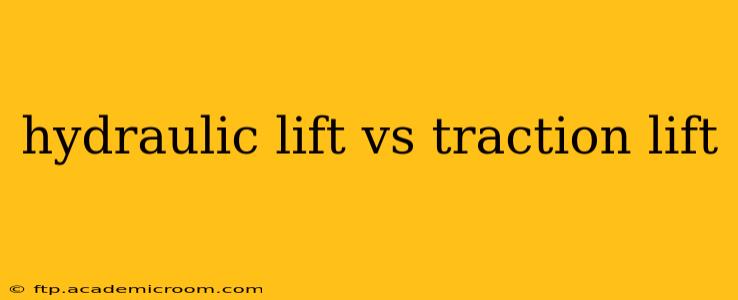Choosing the right elevator system for your building is a crucial decision, impacting both functionality and long-term costs. Two primary types dominate the market: hydraulic lifts and traction lifts. While both achieve the same goal – moving people and goods vertically – their underlying mechanisms, advantages, and disadvantages differ significantly. This comprehensive guide will dissect the key distinctions, helping you make an informed choice.
What is a Hydraulic Lift?
Hydraulic lifts, also known as hydraulic elevators, use a piston and hydraulic fluid to raise and lower the elevator car. A hydraulic pump pushes fluid into a cylinder, forcing the piston (connected to the elevator car) upwards. To descend, the fluid is released, allowing the car to slowly lower under the force of gravity.
Advantages of Hydraulic Lifts:
- Simpler mechanics: Hydraulic lifts have fewer moving parts compared to traction lifts, generally leading to lower initial installation costs and easier maintenance.
- Smaller machine room: The hydraulic pump and other components can be housed in a more compact machine room, a significant benefit for buildings with limited space.
- Good for low-rise buildings: Hydraulic lifts are particularly well-suited for buildings with fewer floors (typically up to six stories), as they offer a cost-effective solution.
Disadvantages of Hydraulic Lifts:
- Limited speed and height: Hydraulic lifts are typically slower than traction lifts and less efficient for taller buildings due to the limitations of hydraulic fluid pressure and piston length.
- Environmental impact: Hydraulic systems often use environmentally unfriendly hydraulic fluids. However, newer systems are increasingly utilizing more sustainable options.
- Higher energy consumption: While initial installation costs might be lower, the ongoing energy consumption of hydraulic lifts can be higher than traction lifts, especially for frequent use.
What is a Traction Lift?
Traction lifts use a system of steel cables and a counterweight to move the elevator car. A motor drives a sheave (pulley) that winds the cables, raising and lowering the car. The counterweight balances the car's weight, reducing the energy needed for operation.
Advantages of Traction Lifts:
- Higher speeds and greater heights: Traction lifts can achieve significantly higher speeds and operate efficiently in taller buildings.
- Energy efficiency: Traction lifts are generally more energy-efficient than hydraulic lifts, particularly in high-rise applications.
- Smoother operation: The counterweight system and precise motor control usually result in a smoother, more comfortable ride.
Disadvantages of Traction Lifts:
- Higher initial cost: The complex machinery and more extensive installation process mean traction lifts typically have higher upfront costs.
- Larger machine room: A larger machine room is required to house the motor, sheave, and other components.
- More complex maintenance: The intricate system of cables, counterweights, and motors requires more specialized maintenance.
Which Type of Lift is Right for My Building?
The optimal choice between a hydraulic and traction lift depends heavily on several factors:
- Building height: Hydraulic lifts are generally suitable for low-rise buildings, while traction lifts are preferred for high-rises.
- Budget: Hydraulic lifts often have lower initial installation costs, while traction lifts may be more cost-effective in the long run due to higher energy efficiency.
- Speed requirements: If speed is a priority, a traction lift is the better option.
- Space constraints: Hydraulic lifts require a smaller machine room, an advantage in buildings with limited space.
- Environmental considerations: While hydraulic systems traditionally rely on less environmentally friendly fluids, newer, more sustainable options are emerging.
Ultimately, consulting with experienced elevator professionals is essential to determine the most appropriate lift type for your specific needs and building specifications.
What are the different types of hydraulic lift systems?
There are several variations within hydraulic lift systems, including those utilizing different types of hydraulic fluid and pump configurations. The specifics will often depend on factors such as the building's height and intended use. Modern systems often incorporate energy-saving features to mitigate the traditionally higher energy consumption associated with hydraulic lifts.
What are the different types of traction lift systems?
Similar to hydraulic lifts, traction lift systems also have variations, often categorized by the type of motor (e.g., geared, gearless), control system, and cable configuration. Gearless traction lifts are known for their smoother operation, energy efficiency, and ability to reach higher speeds, making them ideal for high-rise applications.
What are the maintenance requirements for each type of lift?
Both hydraulic and traction lifts require regular maintenance. Hydraulic lifts generally necessitate less complex maintenance due to their simpler mechanical design, but fluid changes and pump inspections are crucial. Traction lifts demand more frequent inspections and maintenance of cables, counterweights, and the motor system. The frequency and type of maintenance will depend on usage, age, and building codes.
How much do hydraulic and traction lifts cost?
The cost of both hydraulic and traction lifts varies significantly based on factors like building height, capacity, speed requirements, and features. Obtaining accurate cost estimates requires consulting with elevator contractors and obtaining quotes based on your project specifics. Remember to factor in both initial installation costs and long-term maintenance expenses when making your decision.
